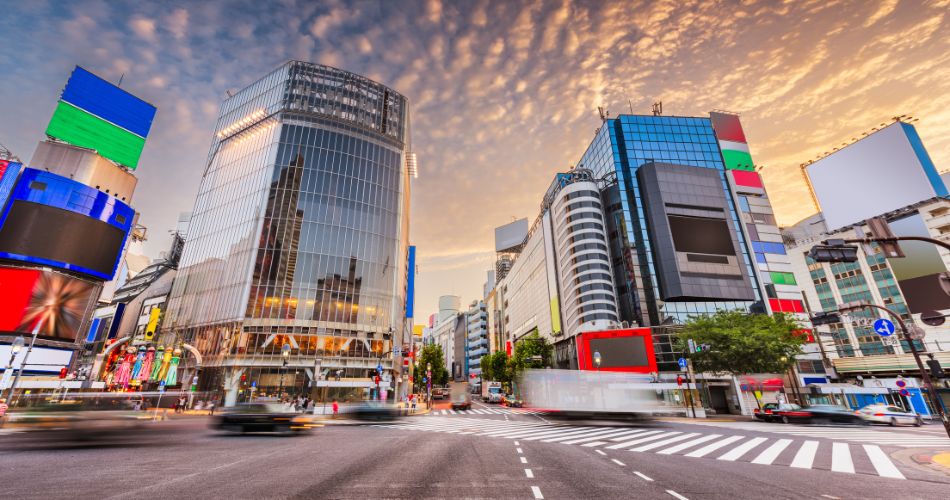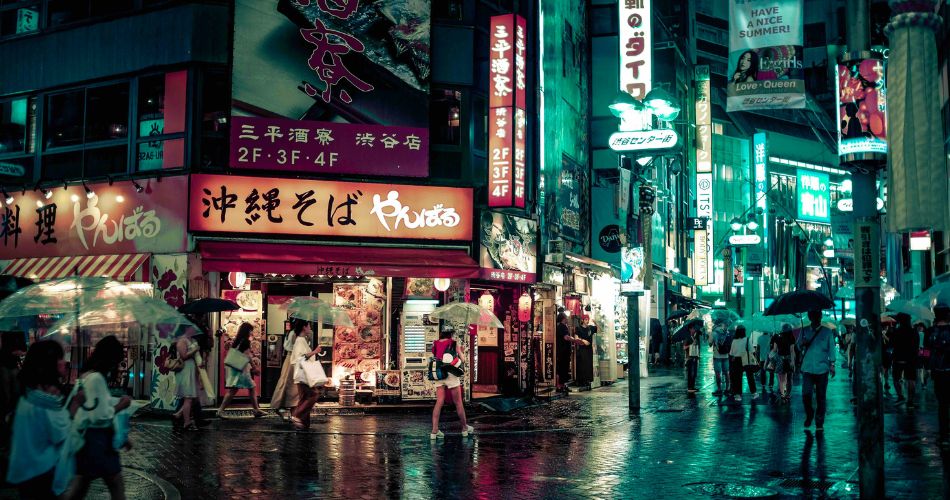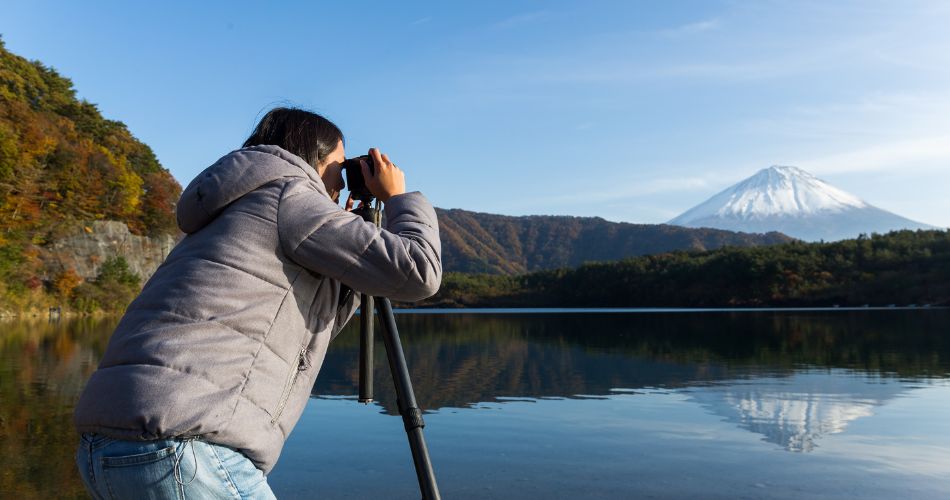Introduction: Discovering Japan Through the Lens
Welcome to a photographic journey through Japan, a country where ancient traditions fuse with futuristic innovation to create scenes of unparalleled beauty. From the neon-lit skyscrapers of Tokyo to the tranquil gardens of Kyoto, each corner of Japan offers a unique story waiting to be captured through the lens.
This guide is designed to lead photographers, to some of Japan’s best spots for capturing those perfect shots that speak volumes about its cultural richness and scenic diversity.
We will traverse the streets of neon-bright cities, wander through mist-covered mountains, and explore quaint villages that time seems to have forgotten. Prepare your camera and let your creative instincts lead the way as we uncover the best spots for photography in Japan, each offering a chance to capture a piece of this country’s soul.
Urban Enchantment
Tokyo Skytree: A View from Afar
Experience the magnificence of Tokyo from a distance at one of its tallest and most striking landmarks, Tokyo Skytree. The structure offers a panoramic canvas of the bustling city below, turning from a vivid urban sprawl by day into a twinkling sea of lights by night.
Best vantage points: Capture the Skytree from the Sumida River banks or the Asakusa district for a backdrop that blends the old and the new.
Photography tips: Early mornings or dusks provide the softest light, ideal for a dramatic effect. A telephoto lens will help capture details even from a distance.
Shibuya Crossing: Capturing the Pulse of Tokyo

Shibuya Crossing is more than just a busy intersection; it’s a symbol of Tokyo’s dynamic energy and urban rhythm. The crossing is a fantastic spot for photographers aiming to capture the essence of city life.
Peak times: For the iconic ‘scramble’ shots, aim for late afternoons or early evenings when the area buzzes with pedestrians.


Shooting advice: Secure a high viewpoint from one of the nearby buildings. The crossing is especially photogenic in the rain, as the wet ground reflects city lights creating a captivating scene.
Dotonbori, Osaka: Neon Nights and Culinary Delights
Osaka’s heart lies in Dotonbori, a district renowned for its dazzling neon lights and gastronomic scenes. This location promises vibrant street photographs filled with color and character.
Key spots: Focus on the Ebisu Tower Ferris Wheel and the famous Glico Man sign.
Best practice: Night photography in Dotonbori is rewarding. Use a wide aperture to capture the brilliant lights and bustling action.
Each of these locations offers unique opportunities to capture the varied urban landscapes of Japan. Photographers can explore these bustling centers not just to take photos, but to immerse themselves in the vibrant culture and history that each cityscape presents.
Historical and Cultural Sites
Fushimi Inari Shrine, Kyoto: Gates to Another Era
Kyoto’s Fushimi Inari Shrine is renowned for its thousands of vermilion torii gates, which weave through the wooded forest of Mount Inari. This site is not only a photographer’s dream for its endless tunnels of bright gates but also a place steeped in Shinto traditions, dedicated to Inari, the god of rice and commerce.
Path to follow: The two-hour trek along the Torii path provides numerous photographic opportunities, from the shrine gates bathed in the soft light of dawn to the lanterns that glow at dusk.
Visitor tips: Visit early in the morning to avoid crowds and capture the ethereal rays of sunlight filtering through the gates.
Todaiji Temple, Nara: Echoes of the Past
In the historical city of Nara, the Todaiji Temple serves as a monumental heritage site, famous for housing the world’s largest bronze statue of the Buddha Vairocana. Constructed in the 8th century, this temple is a testament to the craftsmanship and religious devotion of ancient Japan.
Focus areas: The Daibutsuden (Great Buddha Hall), reputed to be the largest wooden building in the world, offers majestic architectural shots.
Optimal photography time: Late afternoon when the sunlight highlights the intricate details of the temple’s wooden structure.
Kinkaku-ji (Golden Pavilion), Kyoto: Reflections of Gold
Kinkaku-ji, or the Golden Pavilion, is one of Kyoto’s most cherished landmarks. This Zen Buddhist temple is famous for its top two floors completely covered in gold leaf, mirroring beautifully in the pond it overlooks.
Best shots: The pavilion is particularly striking when captured from across the pond, with its reflection shimmering in the water.
Time to visit: Early morning or late afternoon for the best light reflection and fewer visitors.
These historic and cultural sites not only offer incredible photographic opportunities but also a chance to delve into the rich tapestry of Japan’s history and religious life. Each location holds stories and significance that can elevate the depth of your photographic journey through Japan.
Natural Wonders
Arashiyama Bamboo Grove, Kyoto: A Verdant Pathway
Enter the surreal world of the Arashiyama Bamboo Grove in Kyoto, where paths are flanked by towering bamboo, creating a verdant tunnel that seems otherworldly. This spot is not only a favorite among photographers but also serves as a serene escape from the city’s hustle.
Photographic insights: The vertical lines of the bamboo stalks create a natural symmetry, perfect for depth-filled compositions. Use a narrow aperture to keep everything in focus.
Visit considerations: Morning hours are quieter and offer softer light, enhancing the green hues of the bamboo.
Hitachi Seaside Park, Ibaraki: Floral Landscapes
Located in Hitachinaka, Hitachi Seaside Park is renowned for its seasonal floral displays, including vast fields of baby blue-eyes in spring and red kochia bushes in autumn. This expansive park offers a tapestry of colors changing with the seasons, ideal for vibrant landscape photography.
Seasonal highlights: Plan visits during peak blooming seasons; April for blue flowers and October for crimson foliage.
Shooting tips: Use polarizing filters to enhance the vivid colors and manage reflections on sunny days.
Mount Yoshino, Nara: A Cherry Blossom Haven
Mount Yoshino is celebrated for its thousands of cherry trees that cover the slopes in a spectacular display of pink during the spring. It is a historic pilgrimage site with a panorama that has inspired poets and painters for centuries.
Best views: The Hanayagura viewpoint offers expansive views of the blossoms against the backdrop of Mount Yoshino.
Ideal timing: Visit during early April for peak bloom; early morning or late evening offers the best light and fewer crowds.
These natural wonders of Japan provide not only breathtaking scenery for photographers but also a deep connection with nature’s transient beauty. Through careful planning and consideration of the best times to visit, photographers can capture stunning images that reflect the essence of these landscapes.
Modern Architectural Marvels
Tokyo International Forum: A Marvel of Modern Design
The Tokyo International Forum, located in the heart of Tokyo, is a masterpiece of modern architecture, known for its unique glass building that resembles a ship in full sail. This venue is not only a hub for international conferences but also a popular spot for architectural photographers.
Photography tips: The glass and steel structure offers a myriad of angles and reflections. Early morning light accentuates the geometric shapes, creating dramatic contrasts.
Visitor advice: The building is open to the public, and photography is encouraged. Explore both the exterior and the grand atrium inside for varied shots.
Azabudai Hills Sky Lobby, Tokyo: Capturing the City’s Pulse
The newly opened Azabudai Hills Sky Lobby provides one of the most stunning new vantage points of Tokyo Tower and the surrounding cityscape. This spot is quickly becoming a must-visit for both professional photographers and tourists alike.
Best times for shots: Visit during the twilight hours when Tokyo lights up, offering a breathtaking backdrop of the city.
Shooting strategy: Wide-angle lenses are ideal for capturing the expansive views from the Sky Lobby. Night photography settings are recommended to capture the vibrant city lights.
Benesse Art Site, Naoshima: Where Art Meets Architecture
Naoshima Island, known for its contemporary art museums and installations, is home to the Benesse Art Site. The architecture here is a seamless blend of art and nature, designed by renowned architect Tadao Ando. The structures themselves are as much a work of art as the exhibitions they house.
Photographic elements: Focus on the interaction between the stark concrete structures and the natural landscape. The play of light and shadow is particularly striking.
Visit tips: Consider staying overnight on the island to fully experience the art in different lighting conditions, as the ambient changes drastically from day to night.
Each of these modern architectural marvels offers unique photographic opportunities that showcase Japan’s commitment to innovative design and aesthetic beauty. By exploring these sites, photographers can not only capture stunning images but also gain a deeper appreciation for Japan’s contemporary cultural landscape.
Unique and Lesser-Known Photo Spots
Omoide Yokocho, Tokyo: A Glimpse into Tokyo’s Past
Nestled in the bustling district of Shinjuku, Omoide Yokocho offers a stark contrast with its narrow alleys and tiny yakitori (grilled chicken) stalls, reminiscent of post-war Japan. This spot provides an excellent backdrop for photographers looking for a slice of Tokyo’s history amid its modernity.
Photographic tips: The intimate scale and ambient lighting of the alleyways are perfect for close-up shots and portraits. Evening hours bring out the vibrant atmosphere of this dining enclave.
Cultural notes: Be respectful of the patrons and proprietors; asking for permission before taking photos is recommended.
Blue Pond, Hokkaido: Colors of Serenity
The Blue Pond in Hokkaido is a stunning natural anomaly, known for its vivid blue color which changes shades depending on the weather and lighting. Located near the town of Biei, this spot is a bit off the typical tourist path but is a must-visit for landscape photographers.
Best conditions for photography: Overcast days can enhance the ethereal blue of the pond, making it appear surreal. Early morning mist adds to the mystique.
Environmental consideration: The use of tripods is allowed, but photographers are encouraged to stay on the pathways to protect the surrounding environment.
Shirakawa-go Village, Gifu: Traditional Japan in Panorama
Shirakawa-go, a UNESCO World Heritage site in Gifu Prefecture, is famous for its traditional gassho-zukuri farmhouses, some of which are over 250 years old. The village is particularly picturesque in winter when the thatched roofs are covered in snow, creating a fairy-tale landscape.
Photography strategies: Winter provides the classic postcard shot with snow-covered roofs and landscapes. Use a drone for aerial photos to capture the layout of the village and surrounding mountains.
Accessibility tips: While the village is accessible year-round, winter visits require careful planning for travel and equipment due to heavy snowfall.
These unique spots not only offer exceptional photography opportunities but also allow visitors to explore lesser-seen facets of Japan, from its historical alleyways to its natural wonders and traditional villages. Engaging with these locations through the lens offers a deeper appreciation of Japan’s rich cultural tapestry and natural beauty.
Conclusion: Best Spots to Capture the Essence of Japan
Japan offers a treasure trove of photographic opportunities that span from bustling urban settings and timeless historical sites to breathtaking natural landscapes and unique, lesser-known locales. Each location provides a canvas for photographers to not only capture stunning images but also to immerse themselves in the rich cultural and natural beauty of Japan.
As you explore these diverse locations, remember that photography is not just about capturing a moment but also about experiencing and respecting the environment and cultures that make each site unique.
Ready to dive deeper into Japan’s stunning landscapes and vibrant cityscapes?
We invite you to share your experiences, tips, and photographs with a community of like-minded enthusiasts. Whether you’re a seasoned photographer or just starting, your contributions can inspire and inform others.
The information provided in this article was accurate at the time of publication. However, it's important to note that dates, times, fees, and other related details are subject to change without prior notice. We will always make every effort to update the information whenever possible.
Subscribe to our newsletter to get our newest articles instantly!
